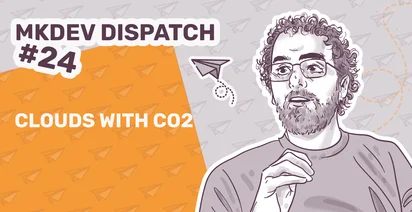Clouds with CO2 | ✉️ #24

Hey! 👋
Everything is currently in the cloud and this has transformed our society. Everyone is connected daily to the cloud, even my old mother is connected as soon as she uses WhatsApp to talk with the grandchildren. But all these changes present a major challenge to our environment. Data centers and cloud computing are becoming significant contributors to global CO2 emissions. However, progress is not without its remedies, and several potential solutions are emerging to tackle this burgeoning issue.
Data centers are the heart of our data-intensive lives, however, data centers consume massive amounts of energy, leading to substantial CO2 emissions. In 2020, they accounted for approximately 1% of global electricity use, a figure projected to rise significantly as our digital dependency grows.
Similarly, the rise of cloud computing has accelerated the demand for data centers. And this is not going to stop. Data is increasing month by month and with that the CO2 emissions.
This intersection of technology and environment prompts a pressing question: How can we strike a balance between our escalating computational needs and environmental preservation?
Several promising solutions are emerging that aim to transform the way we conceive of and construct data centers, as well as how we harness energy for computing. The following are some of the key strategies:
Energy-Efficient Design and Operation: Modern data centers are beginning to adopt energy-efficient technologies and practices. These include the use of advanced cooling systems, server virtualization, and effective power management tools. Such methods can significantly reduce energy consumption and the associated CO2 emissions.
Renewable Energy Adoption: Increasingly, data centers are transitioning to renewable energy sources. Tech giants such as Google and Apple have pledged to power their data centers with 100% renewable energy. Such commitments, coupled with the declining costs of renewables, are gradually shifting the power dynamics in data centers.
Carbon Capture and Storage (CCS): While still in its infancy, CCS is a promising technology that captures CO2 emissions produced by data centers and stores them underground. This technology, if widely adopted, could reduce the carbon footprint of data centers.
Edge Computing: By processing data closer to the source, edge computing can reduce the need for long-distance data transmission, leading to energy savings. It also minimizes the demand for large, centralized data centers, potentially reducing overall emissions.
Recycling Waste Heat: Some data centers have begun to harness their waste heat, repurposing it for local district heating systems. This not only reduces their environmental impact but also turns waste into a valuable resource.
AI and Machine Learning: These technologies can optimize data center operations by predicting peak loads, identifying inefficiencies, and suggesting remedial actions. This could significantly improve energy efficiency and minimize CO2 emissions.
While these solutions offer hope, realizing their full potential requires concerted efforts from industry, governments, and society at large. Policies need to be put in place that encourage sustainable practices, and companies must commit to green strategies.
Ultimately, the battle against climate change involves a multipronged approach. The digital revolution must be an integral part of this, not only as a potential contributor but as a crucial part of the solution. By pursuing sustainable innovation in data centers and cloud computing, we can harness the power of the digital revolution while safeguarding our planet.
What We've Shared
Our YouTube is all about Buildah these days. The Buildah videos include:
Rootless Container Image Builds (with Buildah; it's Buildah all the way down this time):
When to use Buildah instead of Docker? (It is the Dockerless course after all):
But no mkdev dispatch would be complete without a new episode of our podcast!
- 'DevOps Accents', episode 16: Kuberbetes Community, Terraform News and Information Consumption. In this episode, Pablo and Leo talk about KCD Munich 2023, the community built around Kubernetes and some recent mkdev updates.
What We've Discovered
One link this time, and here it is: AI-powered Search & Chat for AWS Documentation.
A few job offerings for you
A DEVOPS ENGINEER and a SENIOR DEVOPS ENGINEER are needed to join a Product Development Team of a digital health organization as soon as possible. It's a remote job, but you will need to be within a reasonable distance from Cologne, Germany to facilitate occasional in-person meetings. Check out the links to find out what the company offers and what it expects from an ideal candidate. Press "I'm interested" on the top of the Job page to apply.
The 25th mkdev dispatch will arrive on Friday, August 18th. See you next time!
